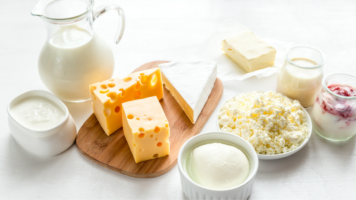If you are following a low-histamine diet it is essential to ensure the omega-3 contribution through the food ingestion or supplementation.
Once the enzyme deficiency has been diagnosed, through the genetic test or the DAO activity in blood, nutrition treatment begins with a low-histamine and other amines diet which also favor their accumulation. On the first visit we almost always recommend starting the first phase diet, that is, a stricter diet. We elaborate it in a totally personalized way, taking into account the patient’s clinical history, their habits, their schedules, their life rhythm, their physical activity, their tastes and their economy. In addition, in case of needing specific nutritional requirements, we try to supply them through food, although sometimes it is not entirely possible and we resort to supplementation.
In this sense, the first phase of a low-histamine diet usually does without some foods which can cause a certain deficit of nutrients. These tend to be:
- Vitamin D
- Vitamin C
- Calcium
- Iron
- Omega-3
However, there are food or food combinations which are suitable in DAO deficiency situations and allow us to provide these nutrients. In vitamin D case we have the egg yolk or in vitamin C case we have the red pepper.
Focusing on omega-3 fatty acids, EPA (eicosapentaenoic acid) and DHA (docosahexaenoic acid), they are essential polyunsaturated fatty acids, so they must be supplied through food. Omega-3 fatty acids are natural components of fats and oils. They are part of cell membranes and therefore are crucial for brain development and cardiovascular health. In addition, they are the precursors of substances involved in the blood pressure regulation, the inflammatory response and blood coagulation.
The main food sources of omega-3 are:
- Oily fish or crustaceans: oily fish such as salmon, mackerel, white tuna, trout or sardines are very rich in omega-3, although they contain moderate levels of histamine. Crustaceans, in the same way as nuts, release endogenous histamine after their consumption. For this reason, it is highly recommended not to include oily fish or shellfish until a second phase of the low-histamine diet and, when they are are going to be included, they should always be fresh or frozen.
- Flax and chia seeds: they are rich in alpha linolenic acid (ALA), a type of omega-3 precursor to EPA and DHA. We can find them in supermarkets or herbalists and we can add them in our salads or vegetable creams from the first phase, since they do not contain histamine. They have to be crushed to be able to take advantage of the fatty acid which they keep inside.
- Walnuts: they are another great source of omega-3 precursors of EPA and DHA, but despite the fact that they do not contain histamine themselves, they produce an endogenous histamine release when are consumed, according to some authors. For this reason, its consumption will be indicated according to the phase diet which is being followed.
- Seaweed: they are part of the fish food chain, so thanks to them we get omega-3 through oily fish. We can also eat them directly and we will do the fatty acid conversion, although it is true that we should eat high amounts of seaweed to get the correct dose of omega-3. The best known seaweed are kombu, wakame, nori and sea spaghetti. Vegan omega-3 supplements are currently on the market and their origin is the Schizochytrium algae.
If you want us to advise you in a personalized way, either in our Barcelona nutrition centre or by video conference from anywhere in the world, contact us and we will help you
As you can see, obtaining omega-3 in the first phase of a low-histamine diet is not entirely easy, so in most cases we recommend adding omega-3 supplementation (of animal or plant origin for those who require it), especially in the initial phases of treatment to ensure optimal levels. Despite the fact that there is a wide range of options on the market, it will be essential to select those which contain the IFOS certificate as a guarantee that they meet quality standards, contain the appropriate omega-3 doses according to the phase in which the patient is, as well as a correct ratio of EPA and DHA.
In conclusion, a low-histamine diet can lead to nutritional deficits. So it will be essential to study each case in detail and personalize the dietary recommendations in the hands of a dietitian-nutritionist specialized in DAO deficiency.
Bibliography
Ajabnoor, S. M., Thorpe, G., Abdelhamid, A., & Hooper, L. (2021). Long-term effects of increasing omega-3, omega-6 and total polyunsaturated fats on inflammatory bowel disease and markers of inflammation: a systematic review and meta-analysis of randomized controlled trials. European journal of nutrition, 60(5), 2293–2316. https://doi.org/10.1007/s00394-020-02413-y
Custodero, C., Mankowski, R. T., Lee, S. A., Chen, Z., Wu, S., Manini, T. M., Hincapie Echeverri, J., Sabbà, C., Beavers, D. P., Cauley, J. A., Espeland, M. A., Fielding, R. A., Kritchevsky, S. B., Liu, C. K., McDermott, M. M., Miller, M. E., Tracy, R. P., Newman, A. B., Ambrosius, W. T., Pahor, M., … Anton, S. D. (2018). Evidence-based nutritional and pharmacological interventions targeting chronic low-grade inflammation in middle-age and older adults: A systematic review and meta-analysis. Ageing research reviews, 46, 42–59. https://doi.org/10.1016/j.arr.2018.05.004
Gao, Z., Zhang, D., Yan, X., Shi, H., & Xian, X. (2022). Effects of ω-3 Polyunsaturated Fatty Acids on Coronary Atherosclerosis and Inflammation: A Systematic Review and Meta-Analysis. Frontiers in cardiovascular medicine, 9, 904250. https://doi.org/10.3389/fcvm.2022.904250



